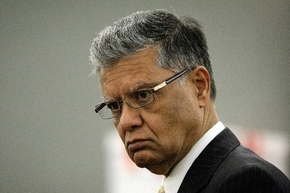Even if Desai defense was more soporific than pyrotechnic, jury kept focus

Fireworks? No.
Drama? No.
Boring? Yes.
The one-day defense put on Tuesday on behalf of Dr. Dipak Desai and nurse anesthetist Ronald Lakeman was a snoozer.
Yawns were prevalent everywhere, including among a few jurors. Some struggled to keep their eyes open. I saw few taking notes, but I wasn’t taking many notes myself.
I had great expectations for defense attorneys Richard Wright and Margaret Standish, both tops in their field.
They had done a superb job of delaying the trial, using competency motions all the way to the Nevada Supreme Court to force repeated postponements and thus allowing Desai and Lakeman precious freedom.
The question of Desai’s competency dates to July 2008, when he had a stroke. It was just four months after health officials disclosed an outbreak of hepatitis cases and recommended people who had procedures at his clinics be tested for hepatitis B, C, and the AIDS virus. Eventually, 64,000 patients were tested.
Desai and Lakeman were indicted in June 2010 on 28 counts, including insurance fraud and murder in the second degree, after the death of patient Rodolfo Meana.
Like many, I wondered: What would the defense be? In light of the seven people who health officials said contracted hepatitis C through unsafe practices at Desai’s Endoscopy Center of Southern Nevada, it seemed like a tough case to defend.
Would there be scads of character witnesses for Desai and Lakeman?
Actually, no. Not a one for either man .
The two defense witnesses were there to give the defense attorneys material to argue when closing arguments start today at 9 a.m. in Judge Valerie Adair’s Courtroom 11C.
The trial began April 22, and state Chief Deputy District Attorneys Mike Staudaher and Pam Weckerly presented people who were granted immunity from prosecution for their own misdeeds to place the blame on Desai. State officials who investigated the case shared what they uncovered. And there was vivid, hard-to-forget testimony about Desai whipping scopes out of patients so fast that fecal matter went flying around the room .
From the prosecution’s standpoint, Desai was in a rush — a rush to make money. And he pushed his employees to do the same.
The defense case is about creating reasonable doubt.
The first defense witness was Dorothy Sims, a state health care inspector, who saw a nurse anesthetist reuse syringes on multiple patients. But Sims told no one that the practice put patients at risk. Only later did an inspector for the state Bureau of Health Care Quality and Compliance write up the clinic for not having a written policy banning using propofol vials for more than one patient.
She gave defense attorneys reason to ask: If reusing syringes was so bad, why didn’t she stop it?
The second witness was Dr. Howard Worman, who sought to provide reasonable doubt about the cause of Meana’s death after his colonoscopy at Desai’s clinic. Worman said Meana had other conditions that could have killed him despite what coroner’s reports in the Philippines and Clark County said.
“I can’t say it (Meana’s death) was caused by hepatitis C,” Worman said.
Two jurors submitted written questions for Worman. One asked if the doctor could say whether Meana would have died from liver complications in 2012 if he hadn’t been infected with hepatitis C.
“It’s not possible to say from the records,” Worman said.
Would the hepatitis C have accelerated Meana’s existing liver and kidney disease?
The liver specialist couldn’t answer that one, either.
The jurors’ straightforward questions showed they may find the medical testimony tedious , but they’re paying attention and deserve our respect, no matter what they decide.
Jane Ann Morrison’s column appears Monday, Thursday and Saturday. Email her at Jane@reviewjournal.com or call
702-383-0275.